Bradbury Update
ISMACS News 98
2010
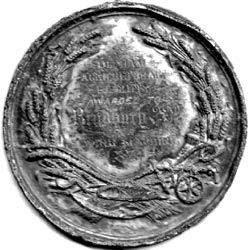
Figure 3: Bradbury Prize Medal 1874
The history of the dawn of the British sewing machine industry is full of black holes, missing machines and missing documents. Firm data is hard to come by and one of the thrills in researching sewing machine companies is being able to share new information. Whilst writing the article on the Lancashire Sewing Machine Co., I also came across some early information about the Bradbury company.
Shown in Figure 1 is an advertisement from early 1855. This is the earliest known advertisement I have come across for the fledgling company that was to become Bradbury & Co. Not only does it give the accurate early name for the firm (Sugdens', Bradbury & Firth - note the apostrophe) but, more importantly, it shows that the business had moved from its humble Primrose Bank premises, where it had started in 1852, to the Rhodes Bank Foundry seven years earlier than has previously been recorded.
It's interesting to note the extensive range of products the firm was making within three years of its founding. At this early date the firm was already involved in industrial machine and tool manufacture, an aspect of the business that would continue throughout the company's history, yet sewing machines seem almost to be mentioned as a sideline.
The partnership of Thomas & Frederick Sugden, George Bradbury and Joseph Firth (yes, I eventually tracked down Firth's forename!) was dissolved on 13th August 1855, with all debts owing to and by the partnership being received and paid by the partnership's late book-keeper, George Ferriman. So can it be presumed that, at that point, it simply became Bradbury & Co? Certainly the firm was using the name Bradbury & Co. by 1859, as evidenced by a patent application.

Advertisement from early 1855
As for the former partners, Thomas & Frederick Sugden had, by 1857, started their own business as machinists and makers of patent sewing machines at Rhodes Bank, Oldham. However, we know that didn't last long as Frederick was adjudged bankrupt in 1861, by which time he had already set up another business with Thomas Lister as Frederick Sugden & Company. Thomas Sugden, on the other hand, went on to become a foreman at Bradbury & Co. and his name appears on several patents.
I have yet to find anything more about Joseph Firth and, of course, George Bradbury went on to become very successful. This success was not obtained, however, without help; as it would appear that the previously mentioned George Ferriman had aspirations beyond book-keeping and, at some point, he went into partnership with George Bradbury.
The partnership was dissolved on 17th October 1862.
In January 1864, George went into partnership with Thomas Chadwick who had, until March 1863, been in partnership with William Jones manufacturing sewing machines at Ashton under Lyne. When Bradbury & Co. became incorporated in 1874, Thomas Chadwick was made Managing Director; a position he held until his death in 1886, aged just 56.

Fig. 2: 1882 Bradbury company indenture
Original documentation relating to the company is very hard to come by. Rarer still is any legal document signed and sealed on behalf of the company, so I was very fortunate to come across an indenture made on 5th April 1882 (Fig. 2). The document relates to the assignment of the lease of 317 Commercial Road, Stepney, Middlesex, to Bradbury & Co. Ltd. These premises subsequently became one of the firm's principal depots, second only in London to its premises at 14 Newgate Street.
The indenture bears the Bradbury company seal which although difficult to make out appears to be an impression of a Belgravia sewing machine.
However, the real thrill for me is that the document is signed by non other than Thomas Chadwick. Other signatories for Bradbury & Co. Ltd. are J. Schofield and Robert Harrop, both as directors of the company, and Thomas S. Walmsley who was the Company Secretary for many years.
I'm not sure how to describe my next find (Fig. 3). It is after all rather tatty, dirty, somewhat misshapen and the back is completely missing. It is the wording which is important. It reads:
"Oldham Agricultural Society awarded to Bradbury & Co. Sewing Machine 1874"
I don't know if this is actually the original medal presented to the company or if it is a replica produced by them. Of over 300 prize medals that were awarded to the Bradbury company, I know of two others that have survived.
Three more Bradbury Sewing Machine price lists have turned up, one from 1898 which has added another industrial type machine to the seemingly ever increasing list of Bradbury machines. This one was the Bradbury Oscillator which was suitable for "Tailors, Wholesale Clothiers, Mantle makers, and all kinds of Boot and Shoe Manufacturing".
The second price list is sadly incomplete and is undated but it must have been published c.1904 as it has an advertisement for the electrically powered No. 6 machine, which was available in January 1904 but which does not appear in the 1905 price list.
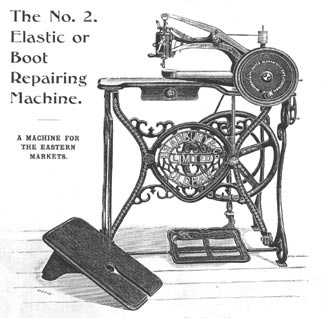
Fig. 4: No. 2 Elastic machine - note size of the arm
There is very little change in the range of machines being sold but there is a machine called the No. 2 Elastic (Fig. 4). This was a variation of the A1 Repairing machine but instead of all-round feed, the feed was only half a circle. The most visible difference was the size of the arm, the end of which had a diameter of 2 inches. All wearing parts were made of hardened steel and the shuttle held 50% more thread than the A1 machine. The No. 2 Elastic was suitable for general boot making and repairing. According to the company it was "well known in the Eastern states".
The third price list dates to January 1880 and is just for Bradbury's industrial machines - two further variations on the A1 Repairing machine are mentioned; one with a smaller arm which had a shuttle box the size of a sixpence (dime) - the standard A1 had a shuttle box the size of a shilling (quarter) - as well another version with a larger arm and a shuttle that held "30 yards of No. 50 Linen thread making it a useful machine for Cloggers, Harness Makers, Coach Trimmers and the like". The Howe principle machine is also mentioned but is referred to as the Letter 'H' and the three well-known versions are included. By this date, these machines were beitg fitted with Bradbury's patent bobbin winder.
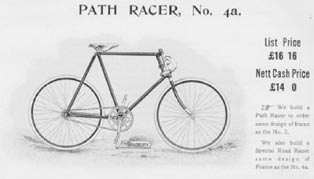
Fig. 5: Path Racer 1902
Two original illustrated Bradbury Cycle price lists have been obtained; these date to 1900 and 1902 and are fascinating in themselves. A couple of the wonderfully detailed illustrations are shown.
Believe it or not, in 1895 a Bradbury cycle was ridden over the Alps by Walter Addy, the Company's Macclesfield agent. So far, this is the earliest mention I have of the availability of the earliest mention I have of the availability of Bradbury cycles. Could it also be claimed it was the first mountain bike?
The company used "The Bradbury" as a generic name for its cycles but they were produced in a number of different designs such as the Path Racer (Fig. 5), Popular Light Roadster, Road Racer, Lady's Safety and two versions of a Tandem (Fig. 6).
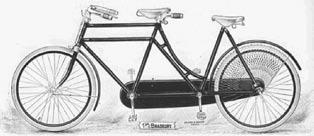
Fig. 6: Bradbury gents & ladies tandem 1900
It would appear from the price lists that the machines were made to order through many of the company's sewing machine Depots and Agencies. The machine could be fitted with a variety of extras including a choice of handle bars, gear cases, detachable mudguards and a brake!
I've added several Bradbury machines to the collection, including two Rotary machines which, I admit, is quite a common machine. However, these two examples are rather special but for different reasons.
The first is a Rotary No. 2 dating to about 1900 (Fig. 7). This one is unusual in that it's mounted on a Ward's Patent Treadle stand. This form of stand was the first introduced around 1884 and although it was made for many years, only a few examples are known to have survived.
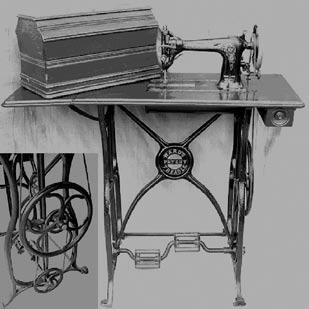
Fig. 7: Rotary No.2 with Ward's Stand
It was designed to use a cycle-type action but it appears to have been predominantly used on the Rotary Shuttle. It was designed to use a cycle-type action which was advertised as being "... an Easy, Graceful, and Natural Motion". The usual speed of all Sewing Machines was greatly increased with "less expenditure of physical force." The stand was patented by Ward's Rotary Sewing Machine Treadle Co., 37 West 14th Street, New York and Bradbury & Co. were the company's agents in Great Britain.
Can any American members shed more light on the Ward Company?
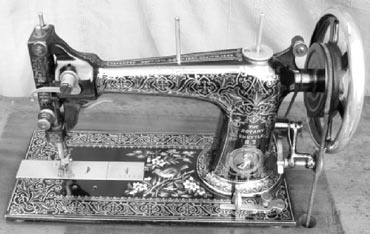
Fig. 8: Highly Decorated Rotary Shuttle B2
The second machine dates to around 1894 (Fig. 8) and is an outstanding example of just how beautiful Bradbury machines could be. I have never seen another Rotary B2 decorated in this way and I have only come across a couple of other Bradbury's which included birds as part of the design, both of which were Family Low Arm machines. As these designs seem to have been produced in limited numbers is it possible they were made to order or, perhaps, for special events?
David G. Best
email: [email protected]
See some of David's great work with Bradburys at www.bradbury1852.co.uk





